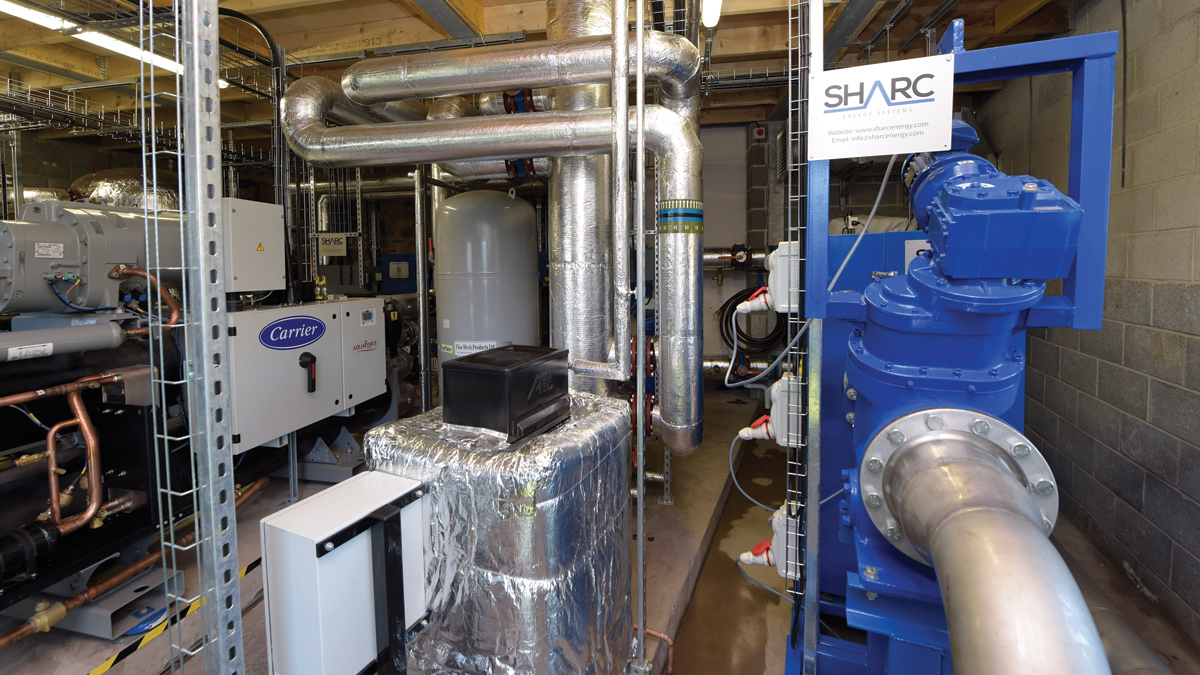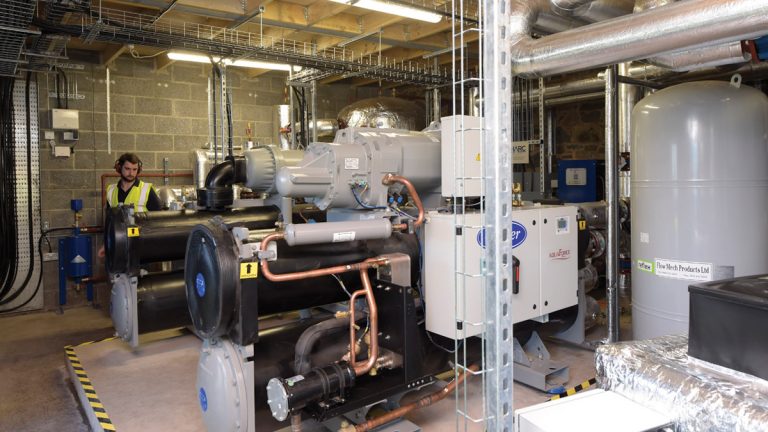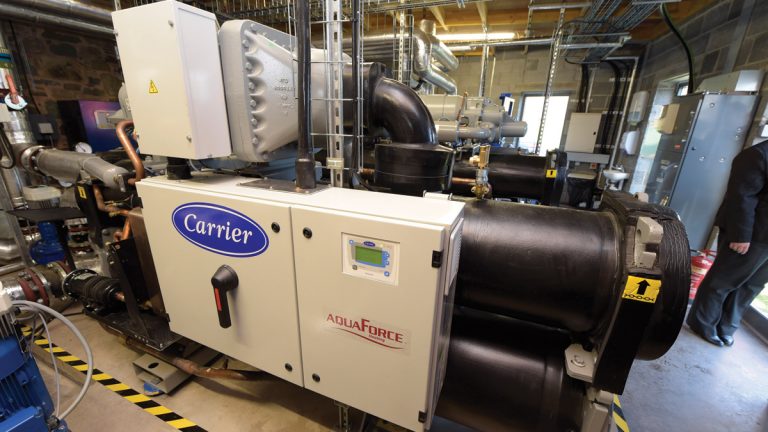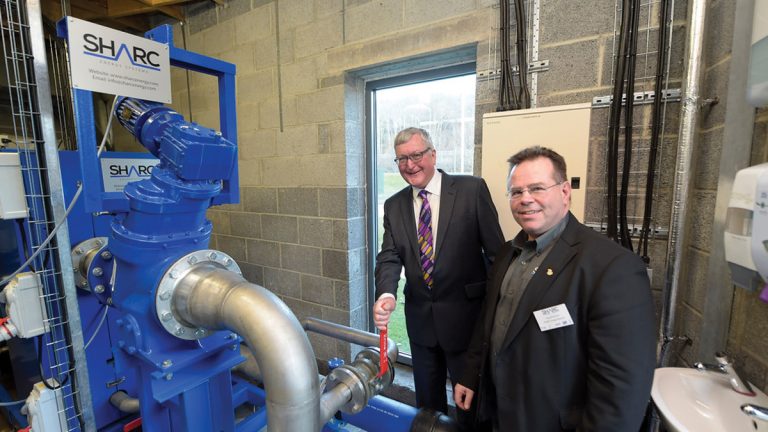Heat from Wastewater (2016)

SHARC unit that separates the liquids and solids - Courtesy of Scottish Water Horizons
Scottish Borders Campus in Galashiels is the first example in the UK of heat being extracted from wastewater networks for use as space heating and hot water, reducing customer costs and carbon emissions. Water that is flushed into the wastewater network from homes and businesses represents a significant source of thermal energy. Usually, this heat is lost as the treated effluent is returned to the environment. A partnership between Scottish Borders College, Scottish Water Horizons Ltd and SHARC Energy Systems has resulted in a scheme that extracts this wasted heat to supply the vast majority of the campus’ annual heating and hot water demand.
The challenge
Scottish Borders Campus developed a carbon reduction plan for their estate, which included reducing the carbon impact of their heating system. This meant identifying a sustainable heating solution which would deliver cost and carbon savings without the need for upfront capital. The campus is shared by Borders College and Heriot Watt University and is located on Nether Road in Galashiels. The campus contains a range of buildings of various stock including the High Mill which dates back to the 1800s.
The solution
Scottish Borders Campus investigated a number of technologies before being introduced to a renewable opportunity by Scottish Water Horizons Ltd to recover heat from the public sewer to meet their heating and hot water needs. The solution involved the use of an innovative SHARC heat recovery system which extracts heat from wastewater. The campus was suitably located to benefit from this technology as immediately north of the site is Gala Water, a tributary to the Tweed River.
On the banks of the river is a 900mm trunk sewer main that takes wastewater from part of the town to the local treatment works around 0.5km to the east.
Wastewater is a plentiful resource and has a number of benefits over using surface water sources. One of these benefits is that the temperature of wastewater is comparatively high all year round (average of around 12-15oC ) while surface water will be at its coldest in the winter months when heat energy is most required. Wastewater is also likely to be available closer to customers than surface water.

Overview of the heat pumps within the Energy Centre – Courtesy of Scottish Water Horizons
The SHARC heat recovery system also had a number of benefits that addressed specific issues the campus had with other technologies, for example space constraints (the SHARC buffer/storage tank is located below ground next to the new energy centre so less intrusive) and delivery of materials to site (wastewater runs within the existing underground network). The technology also enabled cost and carbon savings without the need for upfront capital.
Modelling work carried out in partnership with SHARC Energy Systems also provided assurance that there would be no significant impact on the biological treatment processes within Scottish Water’s local treatment works.

One of the 400kW Carrier heat pumps – Courtesy of Scottish Water Horizons
The technology
The heat recovery system works in three distinct stages:
- The patented SHARC system separates solids and liquids within the wastewater stream via a unique clog-proof mechanical filtration system.
- The warm liquid is passed onto a plate heat exchanger where the heat energy is transferred to the lower temperature side of the heat pumps.
- A heat pump (applying the same physical processes as a refrigerator or air conditioning plant) increases the heat in the clean water circuit, which is used to heat the college buildings and hot water systems. As heat is transferred to the clean water network using a closed-loop system, wastewater never comes into contact with the clean water flow.
Solids that were removed from the wastewater stream are then re-suspended into the cooler water, returning from the heat exchanger, and sent back to the sewer where they are safely treated and disposed of at the local treatment works.
Given the higher temperature of the wastewater the Coefficient Of Performance (COP) that can be delivered from the heat pumps is higher than for a lower temperature source material. The system at the campus is achieving COP values of 4.8 meaning that for every unit of energy that is put into the heat pump it is generating 4.8 units of heat energy.
The scheme
The scheme was delivered by SHARC Energy Systems on behalf of Scottish Borders Campus with support from Scottish Water Horizons to replace the college’s mains gas supply. The main exterior impact of the scheme is the newly built energy centre, adjacent to the Students Union building on an area of land that was previously grassed. This energy centre houses the SHARC equipment along with the heat pumps, all associated pipework, vessels and the control systems.
The system consists of a connection into the existing 900mm sewer which feeds into a small wet well. The wastewater is then pumped over to a larger wet well adjacent to the energy centre. From here the wastewater is pumped through the SHARC system to separate the liquids from the solids.
The warm liquids are then passed through a plate heat exchanger to transfer the heat energy to the lower temperature side of the heat pumps. There are 2 (No.) 400kW Carrier heat pumps in the energy centre which operate on a duty/assist basis. The majority of heating load is done with a single heat pump, but in times of high demand or particularly low temperatures, the second heat pump is used to add extra capacity.
The hot water (circa 60oC) from the heat pumps is stored in a buffer vessel within the energy centre. The five connected plant rooms around the site (Union, Research, Technology Training Centre TTC, Main and High Mill) then request hot water from this buffer vessel when needed to ensure the respective systems maintain set temperatures within their respective buildings/areas.
To supply hot water to the five plant rooms around the campus it was necessary to install 1km of heat network pipes (500m of flow and 500m of return). Pre-insulated plastic heat network pipe was supplied by Flex Energy, a Glasgow based company.
The new heat network connects directly into the existing heating system. The campus chose to retain their gas boilers as a backup to the new system and these are simply inhibited under normal circumstances to let the heat network supply heat. If there is a need for the boilers to operate, the control system will release the inhibitor and redirect the system so that the boilers supply the heat rather than the heat network.
The buildings being supplied by the new heat network are of varying ages and construction types. The High Mill building is a former Victorian mill over 100 years old, the TTC is an area which includes a mechanical workshop with large doors which are often open to let vehicles in for servicing. These buildings provide very different heating challenges particularly when moving from a gas boiler system operating at relatively high temperatures (flow 82oC and return 71oC) to a heat pump solution with a flow temperature of 60oC and a return of 50oC.
All of this work was financed using a heat sale model where the customer, Borders College, did not have to commit to any capital expenditure but instead entered into a 20 year heat sale agreement with SHARC Energy Systems. This heat sale agreement provides the campus with cost savings over mains gas as well as cost certainty in the potentially volatile fossil fuel energy market.
The finance was provided through the Green Investment Bank and private funders Equitix and will be repaid through the heat sale agreement along with the Renewable Heat Incentive (RHI) payments that the scheme attracts from central government.

Russ Burton, SHARC Energy Systems, with Fergus Ewing in the Energy Centre at Borders College – Courtesy of Scottish Water Horizons
The result
Construction on site commenced in June 2015 and was commissioned between December 2015 and March 2016. The scheme was officially opened by Fergus Ewing (then Minister for Business, Energy and Tourism) at an event attended by over 100 people, including representatives from Scottish Water, Scottish Enterprise, Green Investment Bank and many local authorities and public bodies.
The system will supply circa 1.8-1.9GWh per annum of heat, providing the vast majority of the college’s heating needs. So far 125MWh of heat have been delivered to the site and the scheme has generated a lot of interest from both public and private bodies across Scotland as well as other parts of the UK. Over the full annual cycle the college will realise 150 tonnes of carbon savings per annum against their carbon reduction commitments.
The heat from wastewater scheme at Scottish Borders Campus is the first example of its kind in the UK, but there is massive potential for this technology to be rolled out across the country. Scottish Water has over 32,000 miles of wastewater networks, and is using heat maps to actively explore locations where schemes like that at the campus could be developed.
Scottish Water Horizons facilitated safe access to the local wastewater network. SHARC managed the installation and commissioning of the project and is responsible for the on-going operation and maintenance of the scheme.
For further information contact +44 (0)330 123 1331, email [email protected] or visit www.scottishwaterhorizons.co.uk


